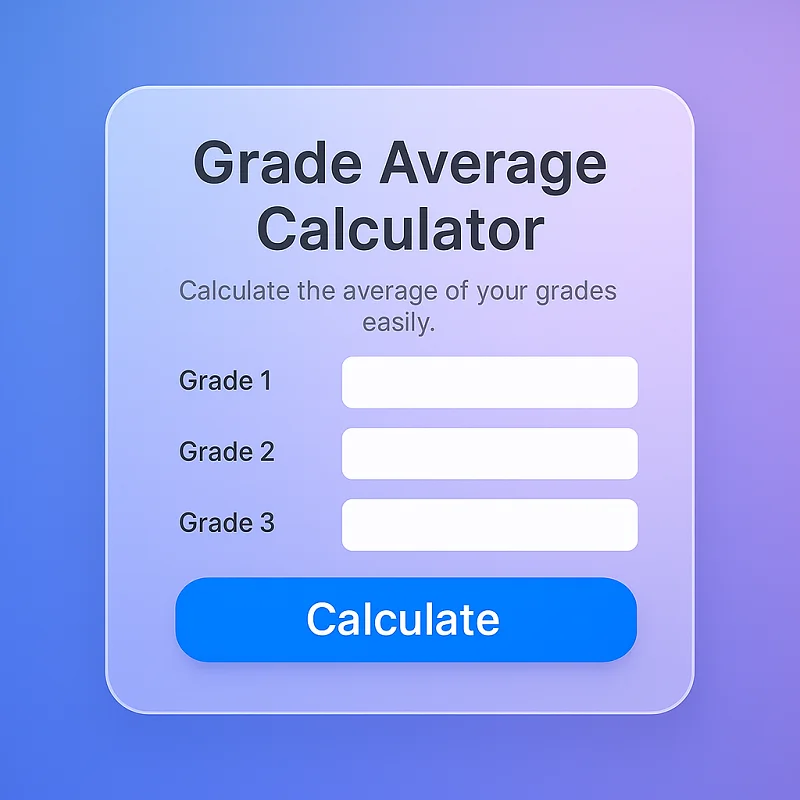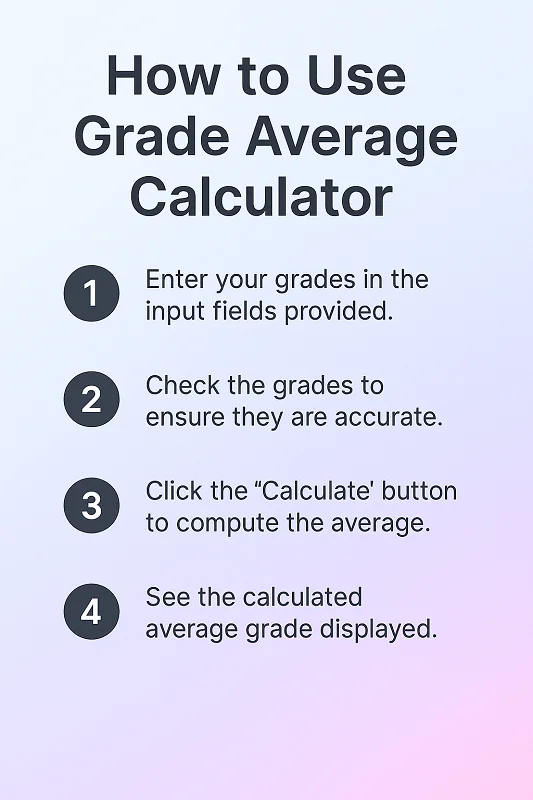Grade Entry
| Subject (Optional) | Grade | Weight/Credits (Optional) | Action |
|---|---|---|---|
Calculate your academic performance with weighted and unweighted averages
| Subject (Optional) | Grade | Weight/Credits (Optional) | Action |
|---|---|---|---|
An average grade calculator is a digital tool that computes your overall academic performance by combining multiple test scores, assignments, and exam grades into a single numerical value. This calculator eliminates manual math errors and provides instant results.
The primary purpose is to help students track their academic progress throughout a semester or school year. Teachers also use these tools to quickly determine class averages and identify students who may need additional support.
Students benefit most from grade calculators when monitoring their academic standing. High school and college students can predict their final grades and identify areas needing improvement.
Teachers use these tools to calculate class averages efficiently. Instead of manually computing dozens of student grades, educators can input scores and receive immediate results.
Parents rely on grade calculators to monitor their children’s academic performance. This helps them understand whether their child is meeting academic expectations and when additional support might be needed.
Most calculators display results in multiple formats: percentages, letter grades, and GPA equivalents.
Manual calculation requires adding all grades together and dividing by the total number of assignments. This method works for simple, unweighted grades but becomes complex with weighted assignments.
Tool-based calculation handles complex scenarios automatically. The calculator manages weighted grades, different point values, and various grading scales without human error.
For weighted grades, manual calculation involves multiplying each grade by its weight percentage, then dividing by the total weight. Grade calculators perform these calculations instantly.
Let’s calculate Sarah’s average grade using five assignments:
Manual calculation: (85 + 92 + 78 + 88 + 91) ÷ 5 = 434 ÷ 5 = 86.8%
Sarah’s average grade is 86.8%, which typically converts to a B+ letter grade.
A weighted grade assigns different importance levels to various assignments. Final exams might count for 40% of your grade, while homework assignments count for only 10%.
This system reflects the actual structure of most academic courses. Major assessments carry more weight than daily assignments, creating a more accurate representation of student mastery.
An unweighted grade treats all assignments equally regardless of their difficulty or importance. Every quiz, test, and project receives the same influence on your final grade.
This simpler system works well for courses where all assignments have similar difficulty levels and educational value.
Use weighted grades when your syllabus specifies different percentages for assignment categories. Most high school and college courses use weighted systems.
Use unweighted grades for courses where all assignments have equal importance. Elementary school classes often use this approach.
Check your course syllabus to determine which method your instructor uses. The grading policy typically appears in the first few pages of the syllabus.

Standard grade conversion follows these ranges:
Letter Grade | Percentage Range | GPA Value |
A+ | 97-100% | 4.0 |
A | 93-96% | 4.0 |
A- | 90-92% | 3.7 |
B+ | 87-89% | 3.3 |
B | 83-86% | 3.0 |
B- | 80-82% | 2.7 |
C+ | 77-79% | 2.3 |
C | 73-76% | 2.0 |
C- | 70-72% | 1.7 |
D | 60-69% | 1.0 |
F | Below 60% | 0.0 |
Note that some schools use different scales. Always verify your institution’s specific grading scale.
GPA (Grade Point Average) uses a 4.0 scale and considers credit hours for each course. A 3-credit course impacts your GPA more than a 1-credit course.
Average grade simply calculates the mean of all your grades without considering credit hours or course difficulty.
GPA provides a more comprehensive view of academic performance across multiple courses, while average grade shows performance within a single class.
United States: Uses letter grades (A-F) and GPA on a 4.0 scale United Kingdom: Uses classifications like First Class, Upper Second Class Canada: Similar to US system but varies by province Australia: Uses High Distinction, Distinction, Credit, Pass, Fail
A final grade estimator helps you understand what scores you need on remaining assignments to achieve your target grade.
Input your current grades and the weights of upcoming assignments. The calculator shows exactly what percentage you need on your final exam to reach your desired grade.
Use grade calculators to explore different scenarios:
These scenarios help you prioritize study time and identify which assignments deserve the most attention.
Students use grade calculators to monitor their academic standing throughout the semester. Regular grade tracking helps identify problem areas before they significantly impact your final grade.
Set grade goals at the beginning of each semester. Use the calculator weekly to ensure you’re meeting these targets.
Teachers input entire class rosters to calculate group averages quickly. This data helps identify whether teaching methods are effective or if curriculum adjustments are needed.
Grade calculators also help teachers provide accurate progress reports to students and parents.
Parents can use grade calculators to understand their child’s academic standing. This knowledge helps them provide appropriate support and celebrate achievements.
Regular grade monitoring allows parents to intervene early when students struggle with specific subjects.

Multiply each grade by its weight percentage, add all weighted grades together, then divide by the total weight. For example: (Test 1 × 30%) + (Quiz × 10%) + (Final × 60%) = Weighted Average.
GPA considers credit hours and uses a 4.0 scale across multiple courses. Average grade simply calculates the mean of grades within a single class without considering credit hours.
Most institutions require a D (60%) or C (70%) to pass individual courses. Check your school's specific passing requirements, as they vary by institution and program.
Yes, grade calculators work for any academic assessment. Input your current grades and the final exam weight to determine what score you need to achieve your target grade.
Calculate your cumulative GPA across multiple courses and semesters. This tool considers credit hours and provides a comprehensive view of your academic performance.
Determine what score you need on your final exam to achieve your desired course grade. Input current grades and final exam weight for accurate predictions.
Convert numerical percentages to letter grades using your institution’s specific grading scale. This tool handles various grading systems and scales.